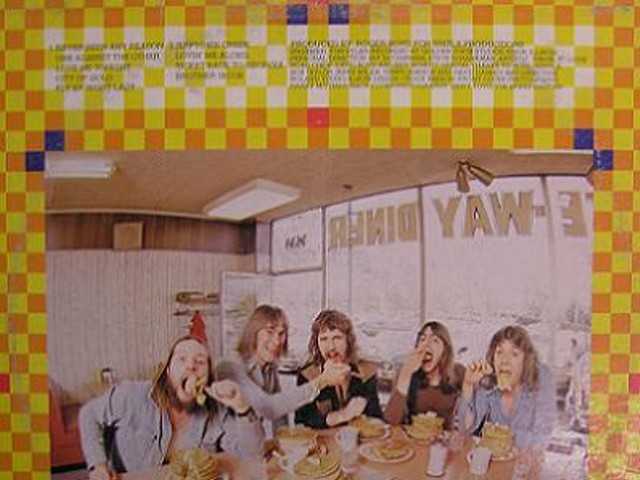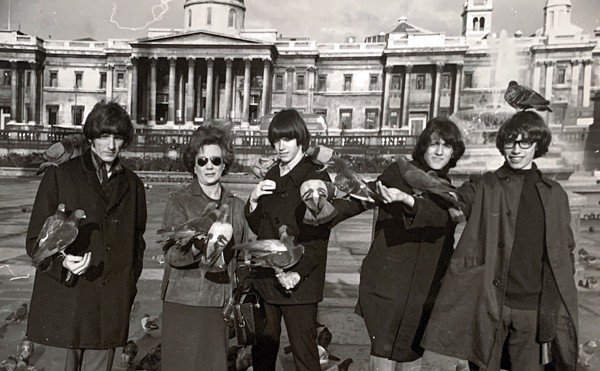Smashing Pumpkins vocalist Billy Corgan is a guitar hero. This is not my declaration, it's actually official: His spindly frame, bald dome and skeleton-like flanges have been motion-captured by Neversoft, the makers of the über-popular Guitar Hero video game series. Corgan appears as a playable character in the franchise's recently released Guitar Hero World Tour, as does a new, game-exclusive Smashing Pumpkins single, "G.L.O.W."
The song recalls much of the drop-tuned supersonic buzzsaw riffage found on the band's 1995 double album, Mellon Collie and the Infinite Sadness. Like the song "Superchrist" (which was also unconventionally released, on a Guitar Center compilation CD last spring), "G.L.O.W." shows promise; it has more raw emotion and a more experimental direction than anything on last year's underwhelming Zeitgeist. (Incidentally, how is it that we as Smashing Pumpkins fans can be so perpetually optimistic about the band's future creative direction, considering its sordid past, checkered reputation and wildly unpredictable frontman?)
But Corgan's legacy as a guitar legend was secure well before people started shredding away in front of flat-screen TVs or tapping out the lead riff of "Today" on a miniature plastic guitar with no strings. By constantly reinventing his approach, his sound and his rig, Corgan forged new frontiers in guitar rock during the '90s, when most thought the genre was at a dead-end. But where did this organic and instantly recognizable playing style come from? What convoluted and seemingly disconnected amalgam of influences could have produced this constantly evolving guitar genius? In honor of Smashing Pumpkins' twentieth anniversary tour, here's a look at Billy Corgan's guitar heroes.
Cheap Trick's Rick Nielsen
Illinois natives Nielsen and Corgan have a well-publicized friendship. Although the former's influence on the Pumpkins may be more figurative (or geographical) than literal, Cheap Trick's infectious rock gems inform some of the more pop-driven moments in the band's back catalog. Nielsen's blazing, overdriven tone and arena-sized riffs definitely shine through when Corgan lets loose and (gasp) has a little fun in the live setting.
Sonic Evidence: "Snail," "Muzzle"
My Bloody Valentine's Kevin Shields
The dreamy walls of sonic bliss and woozy guitar textures on Siamese Dream float along like low-level cloud decks waiting to erupt in a perfect storm of cacophonous noise. Dream producer Butch Vig's recording techniques caused much of this sound, but Alan Moulder's mix lent a decidedly shoegaze vibe to the record (and helped the MBV-esque effects manipulation and sonic experimentation find their place). Although Dream never really sounds like a shoegaze record, the mellotron sound effects and screams, morphing sheets of phased-out distortion and sweeping dynamics all draw from Shields' mastery of mysterious, otherworldly soundscaping.
Sonic Evidence: "Rhinoceros," "Silverfuck," "Bodies"
Black Sabbath's Tony Iommi
Although Corgan is capable of painting just about any mood he wishes, he's particularly proficient at sounding absolutely fucking evil. From the dark psychedelia found on much of Gish to the heavy- metal death-fest of Mellon Collie's insanely thick riffage, Corgan channels the underworld indirectly. Iommi obviously had to go to Hell and back to write something as diabolical as "War Pigs," but Corgan definitely worships at the same altar.
Sonic Evidence: "Window Paine," "X.Y.U.," "Superchrist"
Boston's Tom Scholz
The fact that Iommi and Boston's Tom Scholz appear back-to-back on this list seems unlikely, but makes sense when one looks at the diversity of Smashing Pumpkins' output over the last twenty years. However, don't underestimate Scholz's influence on the slick studio perfection and ultra-produced guitar tones that Corgan strived for on much of the Pumpkins' recorded material. The super-compressed, chunky fuzz tones on Boston's eponymous 1976 release aren't a far cry from much of the intricately constructed walls of distortion heard on Siamese Dream.
Sonic Evidence: "Today," "Muzzle," "Tonight, Tonight"
Fleetwood Mac's Lindsey Buckingham
Surprisingly, a cover of Fleetwood Mac's "Landslide" (an outtake released on 1994's Pisces Iscariot) became one of the band's most popular recordings. Buckingham's gentle finger-picking style and Fleetwood Mac's highly stylized, soothing folk-rock informed much of the lighter fare on Mellon Collie as well as 1998's underappreciated Adore.
Sonic Evidence: "Landslide," "Stumbleine," "Thirty-Three"
Johnny Winter
Blues riffologist Johnny Winter isn't really a guitarist who comes to mind when one thinks about Billy Corgan. But the instrumental jam "Tribute to Johnny" (a B-side on the "Zero" single) proved that Corgan and James Iha had a soft spot in their hearts for the Texas blues master and his brother Edgar. The song's harmonized riffs and deep-pocketed groove showed that Corgan took influence from the blues, even though the genre didn't often manifest itself directly in his music.
Sonic Evidence: "Tribute to Johnny"
Eddie Van Halen
Although Corgan might not be able to quite keep up with the lightning-fast barrage of fretboard-tapping trademarked by Eddie Van Halen, he's often cited him as a huge influence. In fact, Corgan interviewed Van Halen for a 1996 Guitar World article and declared, "Make no mistake. Eddie Van Halen can still kick your ass. The man who single-handedly changed the face of rock is still mean, lean and sharp as a tack. And if you dispute the ownership of the crown, try to imagine a world without him." The blistering solo and deep whammy bar dives of Gish's "Tristessa" pay homage.
Sonic Evidence: "Tristessa," "Geek U.S.A."
Jimi Hendrix
Sure, one almost has to include Hendrix on a list of any guitar player's heroes. But the manual tape-flanging techniques employed on Siamese Dream were a Jimi Hendrix signature, and the '60s-style psychedelic trippiness found on much of Gish also owes a heavy debt to the one true guitar hero. The tastefully lo-fi "Glynis" — a song on the No Alternative compilation that finds the band drawing from Hendrix's "May This Be Love (Waterfall)" — also reveals the influence.
Sonic Evidence: "Bury Me," "Hummer," "Glynis"
The Cure's Robert Smith
Corgan is adept at creating darkly moody atmospheres with his guitar (especially on Siamese Dream and 2000's Machina/The Machines of God), similar to those Robert Smith constructed with synths on the Cure's 1989 masterpiece Disintegration. But Smith's influence also shows through on the drum-machine-driven "1979," with its bouncy, simplistic and clean guitar line. Corgan often employs the same type of straightforward, technically facile riffs that are Smith's trademark, but then juxtaposes them with denser passages of frenzied playing, which adds to the Pumpkins' dynamic intensity. (The band also covers the Cure's "A Night Like This" on the "Bullet with Butterfly Wings" single.)
Sonic Evidence: "Soma," "1979," "The Everlasting Gaze"
Queen's Brian May
The natural harmonic overtones and super-fuzz lead lines of "Rocket" sound about as close to Brian May as anyone can get. (May is known for building his own unique effects pedals and has a modified guitar rig.) In fact, the Pumpkins' most epic guitar constructs emulate the layered orchestral bombast of Queen records. "Thru the Eyes of Ruby" incorporates a harmonized symphony of intertwining guitar lines that echo vintage Queen, calling to mind much of May's thickly overdubbed soloing on A Night at the Opera.
Sonic Evidence: "Rocket," "Thru the Eyes of Ruby"





